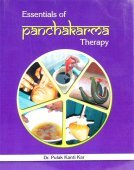Dhanyamla, Dhānyāmla, Dhanya-amla: 9 definitions
Introduction:
Dhanyamla means something in Hinduism, Sanskrit. If you want to know the exact meaning, history, etymology or English translation of this term then check out the descriptions on this page. Add your comment or reference to a book if you want to contribute to this summary article.
In Hinduism
Ayurveda (science of life)
Rasashastra (Alchemy and Herbo-Mineral preparations)
Source: Academia.edu: Ayurveda and Pharmaceutics (rasashastra)Dhānyāmla is another name for Kāñjika: a product made from rice.—The rice that is harvested in sixty days is kept in an earthen pot along with some pieces of radish and sealed and stored for two to three weeks. Gradually, the liquid turns sour in flavour. This is used for detoxification processes in Dolayantra.
Dietetics and Culinary Art (such as household cooking)
Source: Shodhganga: Dietetics and culinary art in ancient and medieval IndiaDhānyāmla (धान्याम्ल) refers to a variety of fermented gruels (kāñjika), according the 17th-century Bhojanakutūhala (dravyaguṇāguṇa-kathana), and is commonly found in literature dealing with the topics of dietetics and culinary art, also known as Pākaśāstra or Pākakalā.—Dhānyāmla can be prepared from rice flour or from the kodrava grain.
Dhānyāmla medicinal effects: It is light and nourishing. It stimulates the digestive fire. It is recommended in loss of taste, all disorders of rheumatism and in decoction enema (āsthāpana) therapy.
Cikitsa (natural therapy and treatment for medical conditions)
Source: Ancient Science of Life: Botanical identification of plants described in Mādhava CikitsāDhānyāmla (धान्याम्ल) or Kāñjika refers to the medicinal plant Hordeum vulgare L. Syn. Hordeum hexastichon L., and is used in the treatment of atisāra (diarrhoea), according to the 7th century Mādhavacikitsā chapter 2. Atisāra refers to a condition where there are three or more loose or liquid stools (bowel movements) per day or more stool than normal. The second chapter of the Mādhavacikitsā explains several preparations [including Dhānyāmla] through 60 Sanskrit verses about treating this problem.
The plant Hordeum vulgare L. Syn. Hordeum hexastichon L. (Dhānyāmla) is also known as Yava according to both the Ayurvedic Formulary and the Ayurvedic Pharmacopoeia of India.

Āyurveda (आयुर्वेद, ayurveda) is a branch of Indian science dealing with medicine, herbalism, taxology, anatomy, surgery, alchemy and related topics. Traditional practice of Āyurveda in ancient India dates back to at least the first millenium BC. Literature is commonly written in Sanskrit using various poetic metres.
Languages of India and abroad
Sanskrit dictionary
Source: DDSA: The practical Sanskrit-English dictionaryDhānyāmla (धान्याम्ल).—sour gruel made of the fermentation of rice-water.
Derivable forms: dhānyāmlam (धान्याम्लम्).
Dhānyāmla is a Sanskrit compound consisting of the terms dhānya and amla (अम्ल).
Source: Cologne Digital Sanskrit Dictionaries: Monier-Williams Sanskrit-English DictionaryDhānyāmla (धान्याम्ल):—[from dhānya > dhā] n. sour rice-gruel, [Suśruta]
Source: Cologne Digital Sanskrit Dictionaries: Yates Sanskrit-English DictionaryDhānyāmla (धान्याम्ल):—[dhānyā-mla] (mlaṃ) 1. n. Sour-gruel.
[Sanskrit to German]
Sanskrit, also spelled संस्कृतम् (saṃskṛtam), is an ancient language of India commonly seen as the grandmother of the Indo-European language family (even English!). Closely allied with Prakrit and Pali, Sanskrit is more exhaustive in both grammar and terms and has the most extensive collection of literature in the world, greatly surpassing its sister-languages Greek and Latin.
Kannada-English dictionary
Source: Alar: Kannada-English corpusDhānyāmla (ಧಾನ್ಯಾಮ್ಲ):—[noun] a sour gruel.
Kannada is a Dravidian language (as opposed to the Indo-European language family) mainly spoken in the southwestern region of India.
See also (Relevant definitions)
Partial matches: Mla, Dhanya, Amla.
Starts with: Dhanyamladi.
Relevant text
Search found 10 books and stories containing Dhanyamla, Dhānyāmla, Dhanya-amla, Dhānya-amla, Dhanya-mla, Dhānyā-mla; (plurals include: Dhanyamlas, Dhānyāmlas, amlas, mlas). You can also click to the full overview containing English textual excerpts. Below are direct links for the most relevant articles:
Rasa Jala Nidhi, vol 2: Minerals (uparasa) (by Bhudeb Mookerjee)
Part 2 - Purification of Bimala < [Chapter III - Uparasa (3): Bimala or Vimala (pyrites with red tints)]
Rasa Jala Nidhi, vol 3: Metals, Gems and other substances (by Bhudeb Mookerjee)
Part 15 - Fermented non-alcoholics (5): Dhanyamla < [Chapter XXXIII - Spirituous liquors (Sandhana or Samdhana)]
Part 1 - Characteristics of Sandhana or Samdhana (liquors) < [Chapter XXXIII - Spirituous liquors (Sandhana or Samdhana)]
Atharvaveda and Charaka Samhita (by Laxmi Maji)
Therapeutics and Rejuvenation Therapy < [Chapter 4 - Diseases and Remedial measures (described in Caraka-saṃhitā)]
Classification of Drugs in the Caraka-Saṃhitā < [Chapter 4 - Diseases and Remedial measures (described in Caraka-saṃhitā)]
Sushruta Samhita, Volume 6: Uttara-tantra (by Kaviraj Kunja Lal Bhishagratna)
Chapter LIV - Symptoms and Treatment of Worms (Krimi-roga) < [Canto III - Kaya-chikitsa-tantra (internal medicine)]
Chapter XXXVI - Treatment of an attack by Naigamesha < [Canto II - Kaumarabhritya-tantra (pediatrics, gynecology and pregnancy)]
Chapter XLIII - Symptoms and Treatment of Heart-disease (Hridroga) < [Canto III - Kaya-chikitsa-tantra (internal medicine)]
Charaka Samhita and Sushruta Samhita (by Nayana Sharma)
Appendix 1 - Description of a Hospital < [Chapter 4]
Rasa Jala Nidhi, vol 4: Iatrochemistry (by Bhudeb Mookerjee)
Part 49 - Diet in indigestion < [Chapter IV - Irregularity of the digesting heat]
Related products
